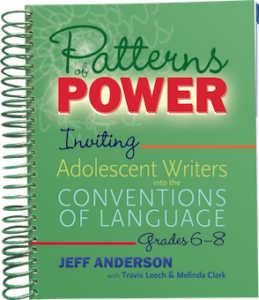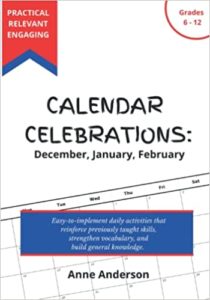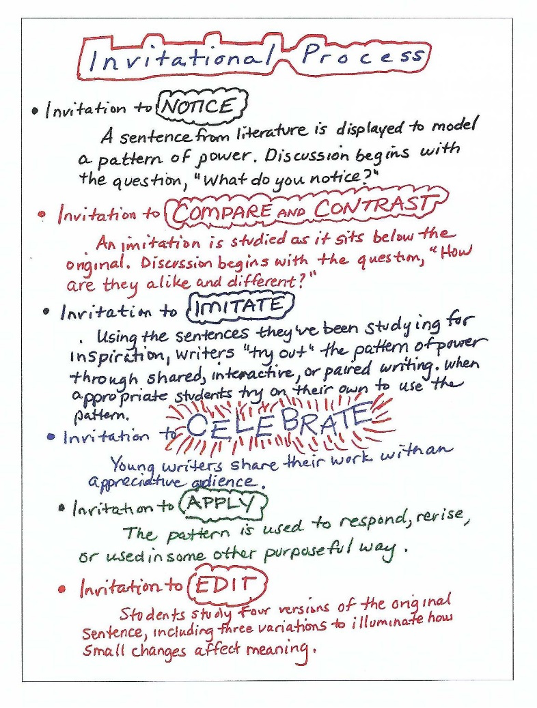Bring Language Patterns Alive for Young Writers
Patterns of Power: Inviting Adolescent Writers into the Conventions of Language Grades 6 – 8
By Jeff Anderson with Travis Leech and Melinda Clark
(Stenhouse Publishers, 2021 – Learn more)
Reviewed by Anne Anderson

You may have taught with grammar worksheets. These author educators share a more palatable approach for teaching grammar and writing with today’s students.
Don’t miss this powerful sentence from the Introduction:
“Instead of hammering adolescents with which mistakes they should avoid, we argue for playing with the patterns of language that mold meaning and have powerful effects on readers, and for creating an environment in which writers study and appreciate the beauty and meaning of grammar and conventions rather than fear and avoid mistakes.” (p. 3)

With the invitation process, students are surrounded with beautiful sentences from an assortment of literature. “Instead of rules, we call the conventions Patterns of Power because this term better represents them.” (p. 3)
Part 1 Getting Started with the Patterns of Power Process
Chapter 1 Into Planning: What Do You Need to Do Before Teaching the Invitation?
Chapter 2 Into the Classroom: How Do You Teach Conventions with the Invitation Process?
Chapter 3 Into Application: How Do You Nudge Writers to Apply Conventions
Here in Part 1 readers receive an overview of the invitation process, while learning about intentional planning, instructions, and application. Some readers may recognize the invitation process from Anderson’s Everyday Editing (2007) and Patterns of Power (2017) for grades 1-5. This section will be extremely helpful for anyone about to embark on this exciting adventure.
Here is an overview of the Invitational Process (p. 10). Students move through this process in ten-minute increments over a series of days. This process is explained in detail in Chapter 2.
Part 2 Patterns of Power Lessons
Chapter 4 How do Writers and readers use SENTENCES?
Chapter 5 Why Do Writers and Readers Need COMPOUND SENTENCES?
Chapter 6 How Do Writers and Readers Use COMPLEX SENTENCES?
Chapter 7 How Do Writers and Readers Use PHRASES and CLAUSES?
Chapter 8 What Does the MOOD of a VERB Do for Writers and Readers?
Chapter 9 How Do Writers and Readers Use VERBALS?
Chapter 10 What Does PUNCTUATION Do for Writers and Readers?
Chapter 11 What Do PRONOUNS Do for Writers and Readers?
Chapter 12 How Do Writers and Readers Continue Using CAPITALIZATION?
Chapter 13 What Other Amazing Things Can Writers and Readers Do?
These ready-made annotated lessons are grouped by writers’ craft and purpose with an easy to follow format. The standard for each lesson was selected from grade-level, state, and national standards and reworded for ease of use. The focus phrase (learning topic) is a student-friendly phrase that students will repeat often in the lesson. Here’s an example from Lesson 7.3 Double the Comma Fun: Interrupters (p.201)
Standard: Use commas to set off nonessential/parenthetical phrases and clauses.
Focus Phrase: “I enclose interrupters in commas.”
Throughout a lesson, you will find Power Notes and Tip Boxes that provide additional support and clarification. That’s where the authors provide the what, why, and how of a particular strategy or activity. Each of the 55 lessons includes the six invitations.
The Invitation to Celebrate will be a big hit with middle school students. It is during this time that students deepen their understanding of conventions. Now they hear, and see, what their classmates created in the Invitation to Imitate. Don’t skip the celebrations. The full Patterns of Power soundtrack is found in Appendix A.
How Patterns of Power works for you
Patterns of Power: Inviting Adolescent Writers into the Conventions of Language Grades 6 – 8 is a teacher-friendly resource. It’s easy to navigate. It’s colorful. It’s filled with ideas. At the conclusion of each chapter readers will find all the necessary printables. It’s a great resource in a world where teaching grammar is more challenging that ever!

Calendar Celebrations: December, January, February is part of Anne Anderson’s trilogy on resources for months of the school year. (For MiddleWeb she wrote about selected winter celebrations here, about fall here, and about spring here.) Anne has also published articles in IDEAS Plus and Voices from the Middle, publications of the National Council of Teachers of English. She is a frequent reviewer of professional books for MiddleWeb.com.






























